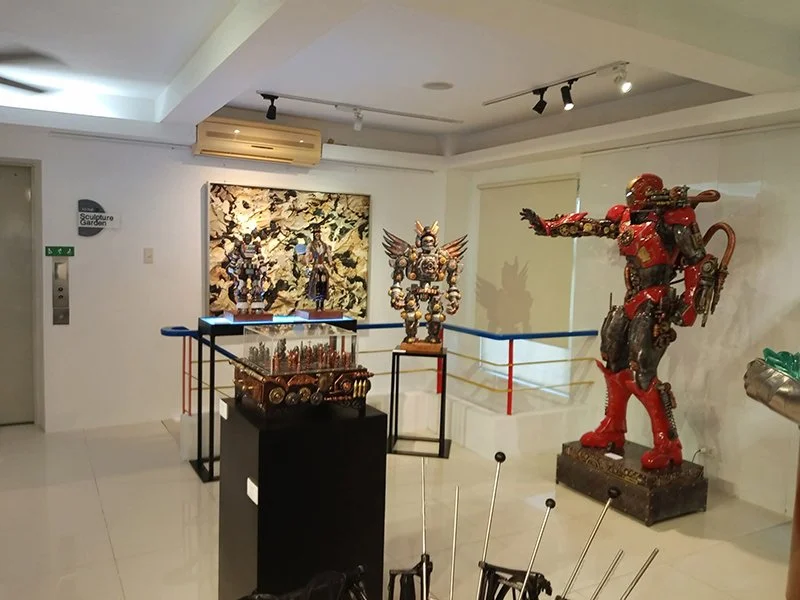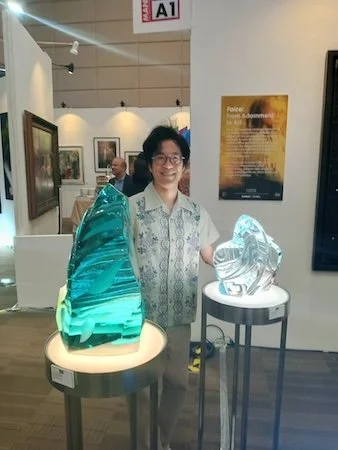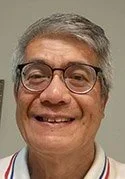Ramon Orlina, ‘Father of Philippine Glass Sculpture’

(From left) Randy David, Ramon Orlina, Kara David, Michael Orlina and Anna Orlina during the ManilART 2025.
It also has a heritage town simply known as Taal, a municipality noted for its balisong (butterfly knife) and barong Tagalog. The town is home to hundreds of heritage structures dating from the Spanish colonial period. Scholars have been pushing for its inclusion in the UNESCO World Heritage List because of its outstanding universal value in terms of natural, built, intangible, and movable heritage.
Taal has also nurtured one of the country’s great Filipino artists, Ramon Gahol Orlina, hailed as the “Father of Philippine Glass Sculpture.” He has transformed industrial waste glass into remarkable works of fine art, making a mark in sustainable art and earning him an award from the Philippine Commission on Climate Change.
Heritage Home Made of Glass
As a young boy, Ramon grew up in his ancestral house in Taal, whose windows were made of wood with colored glass panes rather than the traditional capiz—the oyster-shell window panes that are hallmarks of Philippine colonial architecture.

Ramon Orlina glass works displayed in Museo Orlina in Tagaytay City.
From an early age, he was already fascinated by these glass windowpanes created by his great-grandfather, known in town as “Tonyong Pintor,” or Antonio Medina, who was known for making hand-painted room panel dividers and for using glass as adornment. That early inspiration helped lead him to become the pioneering glass artist in the Philippines. He has earned praise and acclaim worldwide for his unique art, which has helped shape modern cultural perspectives.
He studied architecture at the University of Santo Tomas in Manila and maintained an active practice for 10 years. “I was exposed to Modern Architecture and the Bauhaus Movement with Le Corbusier and Ludwig Mies van der Rohe.” He transitioned full-time into visual arts in 1975 after martial law affected his architectural practice.
Museo Orlina

Ramon Orlina's works.
The (Il)Maestro of glass sculpture later built a museum called Museo Orlina in Tagaytay City, overlooking Taal Volcano. The museum celebrated its 10th anniversary last year.
As a showcase of Ramon Orlina’s artistry, the pioneer and foremost practitioner of glass sculpture in the Philippines, Museo Orlina opens its doors to the public, allowing visitors to view superb examples of his scintillating work for their delight and enchantment.
The museum is committed to supporting and promoting public interest, awareness, knowledge, education, understanding, and enjoyment of modern and contemporary visual art by both local and foreign artists.
Before Orlina, glass was largely appreciated only for its utilitarian functions—as drinking vessels, window panes, or automotive windshields. A visionary, Orlina saw beyond the humble origins of this industrial material. The result is an exultant body of work that, through the decades, has dazzled the art scene and been prized by numerous collectors.
Triumphantly, he has transformed the medium, elevating it to the dignity and respectability of art.
Eskultura IV at Museo Orlina

Steampunk exhibit at Museo Orlina until Nov. 28.
Museo Orlina proudly presents Eskultura IV: Steampunk, a special group exhibition running until November 28, 2025, featuring eight remarkable sculptors known for their distinctive steampunk-themed creations. Steampunk, as a genre, fuses mechanical ingenuity with speculative design—imagining alternate technologies powered by gears, steam, and imagination.
While traditionally associated with industrial metals and found objects, this exhibition expands the language of steampunk by featuring works crafted from diverse materials such as wood, resin, fabric, glass, clay, and repurposed items—pushing the boundaries of form and narrative.
Locally, steampunk has inspired Filipino artists to reimagine sculpture through inventive, sustainable, and fantastical approaches. By combining mechanical aesthetics with local context and creativity, these artists offer a uniquely Filipino take on the genre, bridging craftsmanship with storytelling.
Passing on Artistic Talents
Despite the volcano’s restiveness, Ramon Orlina has left an indelible mark on the worlds of art, culture, and history.
He has also passed on his artistic talents to two of his four children: Anna and Michael, who are gradually making their own names in the art world. Like their father, they work with glass using cold-working techniques.

Michael Orlina
Anna, who earned a Bachelor of Arts in Multimedia Arts, later studied glass sculpting techniques at Pilchuck Glass School in Washington, USA; the Corning Museum of Glass in New York; and the Glass School in Novy Bor, Czech Republic. She specializes in representational, colorful, and vibrant creations, using a variety of glass sculpting techniques. Some of her works are inspired by her experiences in scuba diving, rock climbing, fashion, and pop culture. Rather than merely imitating her father’s work, she combines her unique artistic vision with her family’s tradition.
Her first glass sculpture in 2015, Pastel Sunrise, was a collaboration with her father, merging his signature geometric forms with her novel pastel colors.
She also served as art director and curator for Tagaytay Art Beat, an arts and music festival she co-founded with her sister, designed to draw young people to Museo Orlina.
Before Orlina, glass was largely appreciated only for its utilitarian functions—as drinking vessels, window panes, or automotive windshields.
Michael, on the other hand, creates more abstract, texture-driven glass sculptures. Though he initially focused on arts management and had not planned to become a full-time artist, he ultimately followed in his father’s footsteps, apprenticing under him and receiving training at glass schools in the United States.
His style emphasizes texture and abstract forms, shaping blocks of glass into works that are often suggestive rather than concrete. He continues to experiment with different themes and techniques to establish his own identity within the family legacy.
He is an executive council member of the National Council for Culture and the Arts.
Anna and Michael, along with their father Ramon, have recently participated in collaborative exhibits showcasing their collective contributions to glass art, including MoCAF 2025: RAM: Nature’s Abundance, a special exhibition in August 2025 featuring the works of Ramon, Anna, and Michael.
The title “RAM” represents their initials and reflects their artistic connection and familial bond.


Rogelio Constantino Medina was recently featured in New York City's Time Square billboard for three forthcoming awards: 𝑺𝒐𝒗𝒆𝒓𝒆𝒊𝒈𝒏 𝑺𝒆𝒂𝒍 𝒐𝒇 𝑩𝒖𝒔𝒊𝒏𝒆𝒔𝒔 𝑻𝒓𝒊𝒖𝒎𝒑𝒉 & 𝑹𝒆𝒎𝒂𝒓𝒌𝒂𝒃𝒍𝒆 𝑨𝒄𝒉𝒊𝒆𝒗𝒆𝒓𝒔; 3rd 𝑷𝒉𝒊𝒍𝒊𝒑𝒑𝒊𝒏𝒆𝒔 𝑭𝒊𝒏𝒆𝒔𝒕 𝑩𝒖𝒔𝒊𝒏𝒆𝒔𝒔 𝑨𝒘𝒂𝒓𝒅𝒔 𝒂𝒏𝒅 𝑶𝒖𝒕𝒔𝒕𝒂𝒏𝒅𝒊𝒏𝒈 𝑨𝒄𝒉𝒊𝒆𝒗𝒆𝒓𝒔; and 3rd 𝑺𝒐𝒖𝒕𝒉𝒆𝒂𝒔𝒕 𝑨𝒔𝒊𝒂𝒏 𝑷𝒓𝒆𝒎𝒊𝒆𝒓 𝑩𝒖𝒔𝒊𝒏𝒆𝒔𝒔 𝒂𝒏𝒅 𝑨𝒄𝒉𝒊𝒆𝒗𝒆𝒓 Award. In November 2024, he was recognized in the Amerika Prestige Awards for Inclusive Media Excellence in North Hollywood, Los Angeles, California.
More articles from Rogelio Contantino Medina



No comments: